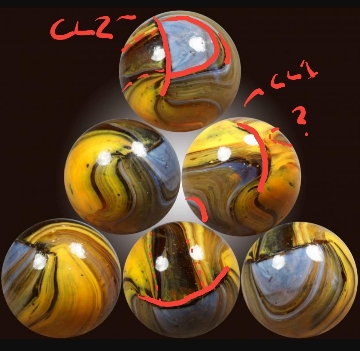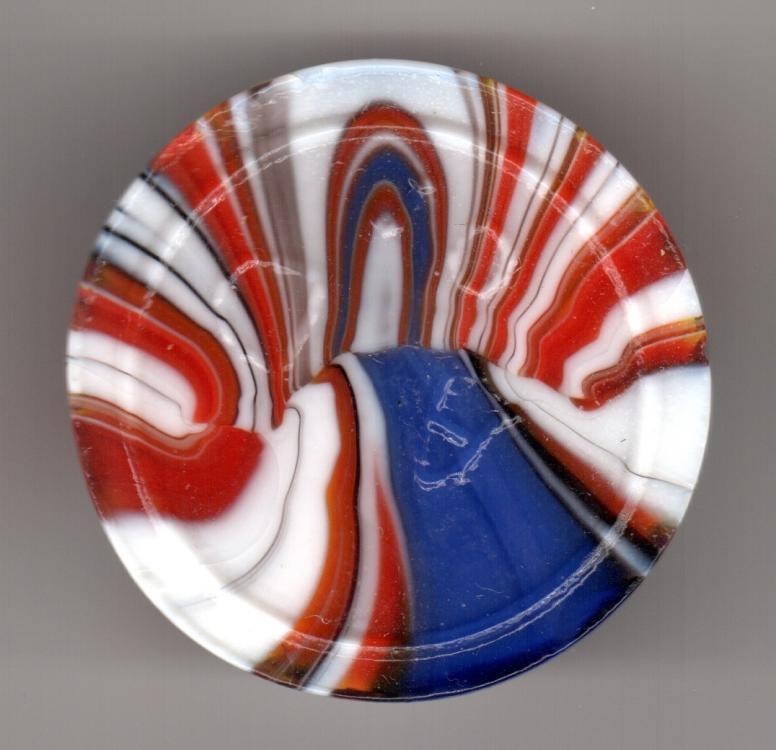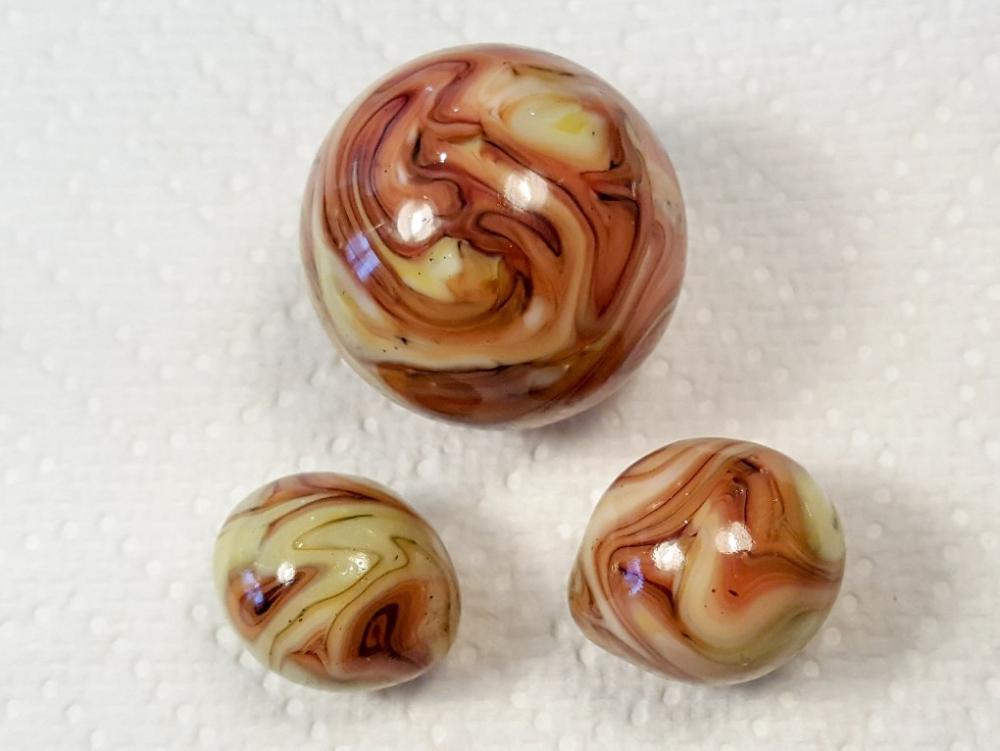-
Posts
676 -
Joined
-
Last visited
-
Days Won
1
Content Type
Profiles
Forums
Gallery
Events
Everything posted by Shamrock Marbles
-
Winnie, Sorry, let me try again. Above is your photo. Let me define "Cut Line 2" as the one that is the focal point of the Road & Tunnel. "Cut Line 1" will be opposite and only shown on the marble in Row 2, Right. I've tried to outline the "Road" with a dashed red line. It appears that the road doesn't completely make it to CL1. I've placed a question mark on the view in question. John
-
Winnie, Your marble is fantastic! I am wondering if you have a double tunnel marble. There isn't a clear photo of how the "clear" tunnel is truncated at the 1st shear mark. The base of the white tunnel is what I would call the 2nd shear mark. John
-
Brian, Again, thank you for sharing your experiences. The "Twist" versus "Dip" definitely has me thinking. Surely, they would result in different patterns. The "Twist" would be a "9" and the "Dip" could give you a "U"? The production rates, also, have me thinking. More later. Do you have a date on the 2nd article? It appears that the number of machines has grown from 6 to 10. Also, it appears they have moved from manual feed to automatic. You bring up a point. Do Akro Slags have similar construction features as CA Slags? Now, I have always been curious about the working time of the glass used to make marbles way back then. A longer working time would allow the glass to stay plastic and minimize a shear mark, while allowing the forming machine more time to form a sphere. Thoughts? Sincerely, John
-
Brian, Always a wealth of knowledge! Thank you for sharing. So that may explain a variation in Slags. At the beginning, when the color pot (transparent purple, blue, green, amber, etc.) is "fresh", the marbles made would have a nice clean transparent base with white striations. After running for some time, any excess white not picked up in the gather would start to bleed and mix with the transparent base. So, slags toward the end of a pot would have a "cloudy" or "milky" transparent base. Thoughts? The comment "do not gather but dip the glass" is very interesting. Thoughts on what this means? Hope all is going well with you. Sincerely, John
-
Winnie, I don't know if anyone can definitively answer your question with a 100% "Yes" about your German sample. I don't recall ever seeing anyone post information as to what technology the German's employed and the relevant time-frames. It would be safe to say that the consensus was that 100% of MF Christensen marbles were "Hand Gathered" and "Machine Rounded". It would be safe to say that early Christensen Agate marbles were "Hand Gathered". It would be safe to say that later Christensen Agate marbles were "Machine Stream/Gob Fed". Now where it gets dicey, is what varieties were "Hand Gathered" or "Machine Stream/Gob Feed". All is open to argument. Others might add that early Peltier and Akro marbles were "Hand Gathered". Some might argue that the early Akro "Hand Gathered" marbles were actually purchased MFC stock. I think what Chris is stating that his marbles derive their pattern from the "twisting", "stretching" and "folding" actions done while "Hand Gathering". He is also implying that the MFC 9 and CA Diaper Fold patterns were generated by "Hand Gathering". Personally, I agree. Here is an Andy Davis Marble/Top Stand. I believe these are single "Hand Gathered" and then sheared off into a press/mold. Notice the beautiful striations and "Road and Tunnel" pattern? Obviously, Chris' marbles and Andy's stands have a single shear mark. Your German marble exhibits two shear marks. It is this twin feature that lead some to believe that this was "Stream Fed" and not "Hand Gathered". My belief is that a "Hand Gathered" marble can have a single shear mark, but also two shear marks. Sincerely, John
-
Steph, Same as the marbles. The forehearth technology was the same. You just rolled your "forming" machine underneath. Sincerely, John
-
-
-
-
-
Even a blind squirrel can find an acorn once in a while. Stumbled across this early Chris' Robinson postcard. This must have preceded the branding of "Road and Tunnel Slag", as these marbles are called "Super Slags". Circa 1993/1994. Enjoy! John McCormick
-
Craig, Glass was purchased from Gabbert Cullet. So, whatever they bought as scrap and re-sold around 1993. The scrap had animal shapes. High probability it was Fenton. Gabbert sold tons of Fenton. I need to check mine under UV! John
-
Craig, I do have more information to share. Chris informed me that this was a very early "experimental" version of the R&T Slag. Not only was this a "developmental" marble, it was an "unusual" size (31/32"). Due to difficulties getting the machine to round, Chris cut the gather off the punty and into a "cup mold". The goal was to "pre-round" the gather as much as possible "before dropping on to the rollers". This was an early effort that he abandoned. "The cup mold was not completely finished and had circular machined marks." This makes sense, since you stated that your indentation is opposite the cut-mark. Hope this info helps. Now, I need to go look at my samples to see if there are any similar indentations! Sincerely, John McCormick "Shamrock Marbles"
-
Craig, Even more perplexed. I can't imagine what caused this. Sorry. Now, I can tell you that when we make larger marbles (1-1/4"+), we have to be very careful about when to remove from the marble machine. Even if the exterior seems cool and "set", the inner core can still be very hot. If you place a marble in the annealing kiln with a super hot core, that internal heat will migrate back to the surface. The surface can soften and the weight of the marble will create a flat spot (or an impression of the shelf material). Sometimes, a marble can slip through or jump out of the rollers. If it lands on something, it will make an impression. I just can't think of anything on Chris' machine that would make this mark. Again, sorry for not being much help. John P.S. I have always wanted to see Andy Davis make his marble/top stands. If you look at the bottom, they display a perfect "Road & Tunnel" pattern. A few years back, Alan sent me some beautiful examples.
-
Craig, No problem. Posts get buried quickly. As far as that indentation, I am puzzled. Could it have sat on something on the annealer? Maybe. Is that a concentric ring around the indentation? Does that area appear to be more "bubbly" than the rest of the surface? Sorry for more questions. John
-
Good morning, everyone! John
-
Shamrock says, "Howdy." Glad to see you post! John
-

Veiligglas Original Packaging
Shamrock Marbles replied to BuckEye 's topic in General Marble & Glass Chat
An additional thought... We know when the Closure was invented and when Veiligglas ended. One would suppose the dates were between 1957 and 1961. However, Craig noted the wording on the closure as "CARRY-SEAL II". Usually, when a patent approaches expiration, that invention is "modified" or "improved", so that product protection can be extended. Version 1 of the closure may have read "CARRY-SEAL" and Version 2 would be "CARRY-SEAL II". Maybe, the marbles were made before 1961 and stored in bulk boxes. They could have been packaged in smaller mesh bags much later (but before 1989) for Shackman to sell. Pure speculation on my part. Thanks, John -

Veiligglas Original Packaging
Shamrock Marbles replied to BuckEye 's topic in General Marble & Glass Chat
Okay, here is what I was able to find... The closure device is of German Patent origin from c.1957-1960. Inventor Hans Brenker (assigned to Neoplastik Braunschweig Kunststoffwerk) was awarded US Patent 2951273. https://www.google.com/patents/US2951273 It would be safe to say that Neoplastik made the closures and Hans was an employee. So, these packages could have been made and boxed from 1957 (creation of closure) to 1961 (end of Veiligglas). Very cool! John -

Veiligglas Original Packaging
Shamrock Marbles replied to BuckEye 's topic in General Marble & Glass Chat
Craig, What does the raised printing on the inside of the blue clip say? John -

Veiligglas Original Packaging
Shamrock Marbles replied to BuckEye 's topic in General Marble & Glass Chat
New Old Stock from a warehouse find and packaged for contemporary consumption? Shackman had a retail store in Manhattan. https://retail.shackman.com/ "For children over 3 years" is a voluntary label applied by toy manufacturers/retailers. "The Child Safety Protection Act", 1994, enacted specific labeling for marbles. So, pre-1994 for sure. Possibly 1980's? John -
At least there was a dial caliper in the background. The lack of photos showing all sides and how the fingers can obscure possible defects or roundness would bother me. The cut-line is interesting. John
-

Corky and his brother Patch
Shamrock Marbles replied to bumblebee's topic in General Marble & Glass Chat
Let's suppose... When getting the glass stream flowing, the spinning cup is retracted and the marble machine is pushed away. This glass piles up on the floor, to be later dug as cullet. Once the flow is consistent, the marble machine is rolled into place. Patch marbles are being produced, while the stream is adjusted to get the right size marble. Once all looks stable, the spinning cup device is engaged. Corks are now produced with the same colors as the patches before. If you look at the patent for the spinning cup, it is not overly robust. I also speculate that this device failed regularly and required it to be disengaged during a run. Corks stop and Patch production resumes. Corks would resume as soon as the device was fixed. My belief was that Cork production was the ultimate goal, but Patches are a natural by-product. Why toss a perfectly good marble? YMMV, John P.S. Both are awesome in their own way!




.thumb.jpg.5ae42e60567e9b3789658b2dcfd32ee4.jpg)
.thumb.jpg.c062de8b1ac6be04aa4ca8e7940d4c80.jpg)
.thumb.jpg.80d43a51c6ae4f4bb5175865cd51bc4a.jpg)
.thumb.jpg.03b44d000ecae536feb5317bd813ce5e.jpg)
.thumb.jpg.d52953ce5907de61397de5c201578751.jpg)
.jpg.58275ff92f5a55247f9c2aa1d94a4b8f.jpg)
.jpg.d61a2c177f0ed2f2f5ead230517d64c2.jpg)

